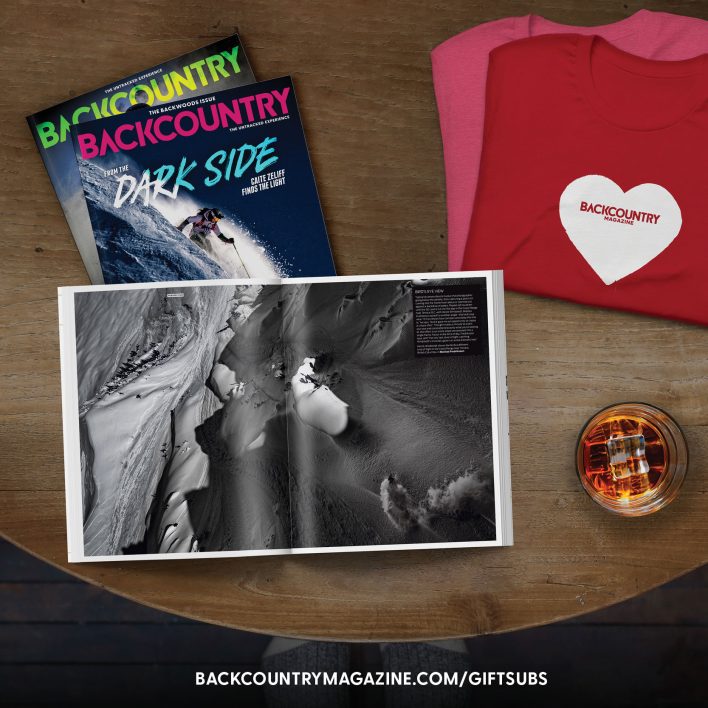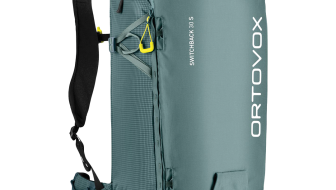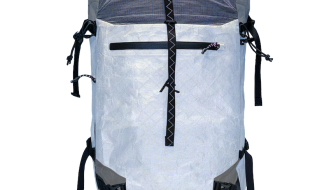
Bridget Grove studies up in Keith’s Hut near Pemberton, B.C. [Photo] Garrett Grove
The list of skills and knowledge needed to get into the mountains is never ending. In fact, it’s subject matter that numerous careers are built on, but safe and efficient backcountry travel doesn’t necessarily require a PhD in snow science or a guide’s certification. It takes common sense, good partners, a willingness to learn and, above all, the following 10 things that every skier and rider should know.
Safety Goes Beyond Avy Gear
Beacon, shovel, probe: it’s the universal morning checklist for skiers and riders. But often not included in this list are items of equal importance like a headlamp, bivy sack, first-aid kit and spare pair of gloves.
“If you have wet clothing and nothing to change into, that can be pretty dangerous, actually, especially if you’re stuck out overnight, unplanned,” says Jeffery Halleck, a former University of Utah internal medicine resident, who explained the effects of hypothermia on buried avalanche victims in the December 2016 issue. Preparedness means more than knowing how to use a beacon—it means being ready for the unexpected.
Nerds Save Lives
In the mountains, nerds are your friends. From understanding how to properly operate avalanche gear to knowing how to read terrain, pursuing an advanced backcountry education is critical to safety, and learning is an ongoing process.
“Take a course and advance your knowledge. Then, take the next level course,” Sarah Carpenter—a certified guide and co-owner of the American Avalanche Institute, an avy ed organization—says in a recent story on backcountrymagazine.com. “There are tools in each course for recreationists and professionals alike. If it’s been a while since your last course, take a refresher course.”
And while learning about avalanche safety is crucial, it’s not the only subject to study—sharpen first-aid skill with regular CPR refreshers and courses in wilderness medicine, too.
Avoid the Dreaded Bonk
Being well fed and hydrated means more laps and more face shots. And being well fueled is vital for having the energy required to make sound decisions and travel comfortably and efficiently through cold environments.
“Things change in the winter, and the cold changes how we keep hydrated and fueled,” says Dr. Allen Lim, a sports physiologist and the founder of Skratch Labs, in a recent story titled Can what you eat earn you another lap up the skintrack?
Bonk avoidance requires bringing the right food and the self-awareness to know to stop and chow down or drink. Claudia Pearson, Rations Manager at the Lander, Wyo. Rocky Mountain branch of the National Outdoor Leadership School (NOLS), advises the following: “What we have always said here at NOLS is to eat a variety of food, eat throughout the day and hydrate often.”
Know Whom to Trust
The key to making good decisions is ensuring open dialogue about a day’s objectives and hazards. “Some days, the conditions just aren’t right for skiing or riding a specific line,” Sarah Carpenter explains in a recent story on why good partners matter. “I want to travel with someone who can adjust plans based on pertinent observations.”
“I want decision making to be a conversation,” Carpenter adds. “As for those partners who have given me a hard time about wanting to turn back when I didn’t like the conditions? I’ll go out for a beer or a cup of coffee with them, but I’ll no longer ski with them.”
Look Around, Not Just at Your Skis
“Context is just as important to digging a pit as a shovel and snow saw,” Chris Lundy, the co-owner of Sawtooth Mountain Guides, explains in a story on backcountrymagazine.com on decision making and snowpack tests. “You need a big-picture forecast to frame small-scale data points.” And slogging head down through the mountains might mean missing important indicators of stability or instability. Observations come from everywhere, not just a pit or a forecast—the trick is learning to apply these tools to guide the day’s objectives.
“There are days when field observations are as or more valuable than snowpack tests,” Lundy adds. “The key is to use all available information to confirm or deny your stability forecast.”
Really Read the Forecast
Avalanche forecasts and the information they encompass can be quite extensive. And all that accurate and up-to-date insight into the snowpack can be difficult to digest, but rather than simply reading the forecast, understand how it should impact and influence a day in the mountains. Based on the hazard rating, what terrain should be off limits? What further information should you plan to gather? What signs of instability should you look for?
“The forecast that [an] avalanche center issues should be used as a hypothesis for your travel day,” says Sarah Carpenter in her article, How to really read the avalanche forecast. “Test it while you are in the field and prove or disprove the hazard rating through snow and weather observations.” Use forecasts as guides, not gospel.
Keep Skins Dry
As ski mountaineer Andrew McLean states on his blog, straightchuter.com, the experience of failing skins is “hateful, hateful, hateful.” Skin failures can lead to cutting a day short, slogging on globbed-up or partially functioning skins or, worse yet, becoming stranded.
McLean advises always putting skins on at home where it’s warm and dry to ensure they’ll stay well adhered, at least for the first lap, which he often aims to make the longest, while skins are well stuck. For on-mountain care, he recommends keeping skins inside a jacket to help keep the glue warm.
“On colder days, I’ll carefully fold them in thirds and put them inside my jacket while I’m skiing down,” he says. “This way the heat from my body helps to break down the ice crystals on the glue. I’m also careful about not dropping the skins into the snow, especially the glue side.” Finally, treat skins right at home, too, ensuring they dry thoroughly at night and spend summers in a cool, dry place.
Do Unto Others
As more skiers and riders enter the backcountry fold, more pressure falls on everyone to be aware of his or her surroundings. Nobody is out there alone, so it’s important to consider others when developing a plan for the day—will other groups be above or below yours?
“Sales of backcountry-related equipment document what we already know: there are a lot more people in the backcountry these days,” says Steve Banks, a certified guide based in Crested Butte, Colo. “We need to adjust to this new norm and be proactive about communicating not just with our group, but also with other parties in the area. Instead of racing people from the trailhead or on the skintrack, stop and talk with them. Where are they going? What is their plan?”
There is No Shame in Turning Back
Waning daylight, too much sun, whoomphing, questionable stability—the reasons to choose to call it quits and turn around are endless. And giving up the chance to top out on a peak or ride a coveted line can be hard. But as Donny Roth explains, “I ask myself: Is continuing uncomfortable and scary? Is it dangerous? I always take a moment, put on warm clothes, eat and drink, calm down and try to make a rational decision.”
But sometimes retreat is the safest and best option. “Turning around before reaching the objective is always tough,” Roth says. “It can be frustrating, even heartbreaking. When faced with this, I often remember the adage, ‘I’d rather be in the valley here wishing I was on the summit, than on the summit wishing I was in the valley.’”
Tailgate in Style
Sure, there’s the saying “No friends on a powder day,” but friends make the backcountry a better place. And an essential way to thank your buddies for a safe and successful day is through proper tailgating technique.
This step in the process of a day of touring may seem simple, but planning makes for better après. Stash a cooler filled with snow in a snowbank, don’t forget where you buried it and bring coozies. At the end of a big mission, however, après is not about what you bring, but who you are with.










Related posts:
Mountain Skills: Managing Risk and Responsibility
The Skills Guide: Four Steps for Managing Avalanche Hazards
Mountain Skills: Making Better Observations
Pit Maneuvers: Snow pit tests and digging protocol